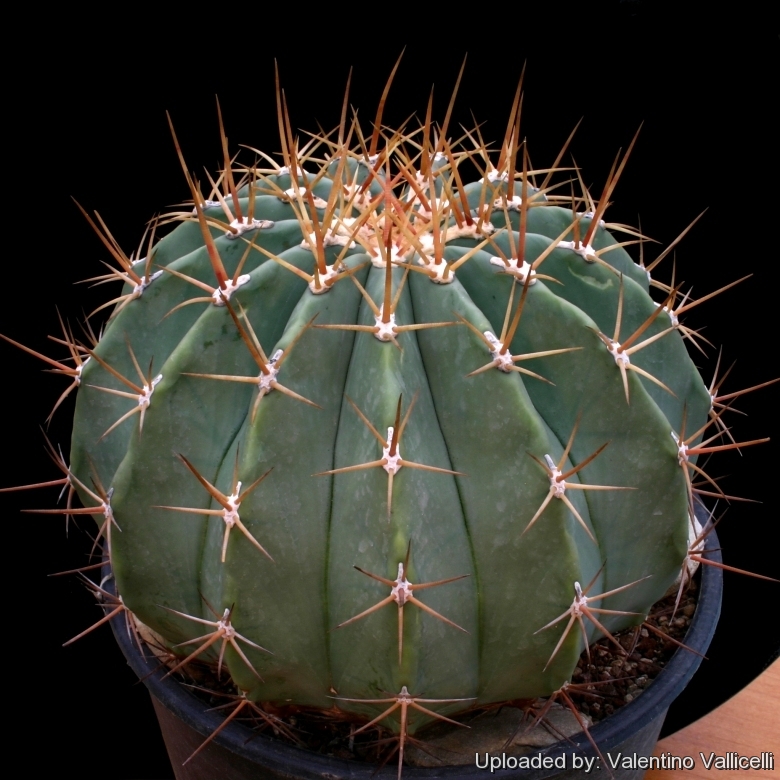
Ferocactus pottsii Photo by: Valentino Vallicelli
Origin and Habitat: Mexico (Chihuahua, Sinaloa, Sonora)
Altitude: From 240 to 1000(-1800) metres elevation.
Habitat and Ecology: Ferocactus pottsiiSN|15546]]SN|15546]] occurs in tropical deciduous forest up to the pine forest, in Sierra Canela, Chihuahua. This species is known from only three locations and is not very common where it has been found. The habitat of Ferocactus pottsiiSN|15546]]SN|15546]] is home to succulent and arborescent flora and is particularly rich in local endemics such as: Echinocereus tayopensisSN|16544]]SN|21771]], Echinocereus subinermisSN|21771]]SN|16544]], Mammillaria floresiiSN|23715]]SN|9424]], Mammillaria canelensisSN|8836]]SN|23734]], Mammillaria gueldemannianaSN|23734]]SN|8836]], Mammillaria craigiiSN|9424]]SN|23715]], Peniocereus greggiiSN|8088]]SN|8088]], Stenocereus thurberiSN|8265]]SN|8265]], Pachycereus pecten-aboriginumSN|8498]]SN|8498]], Opuntia thurberiSN|19931]]SN|10801]], Opuntia lindheimeriSN|10801]]SN|19931]], Ipomea arborescens, Agave shrevei, Agave vilmorinianaSN|22560]]SN|22560]], Agave bovicornuta and also Acacia farnesiana, Populus fremontii, Antigonon leptopus, Bursera laxiflora, and the palm Sabal mexicana.
Synonyms:
Description: Ferocactus pottsiiSN|21495]]SN|15546]] is a mall barrel cactus, usually solitary but it sometimes clumps at the base.
Stem: Depressed, globose to shortly cylindrical up to 90 cm tall and 45 cm in diameter, occasionally much taller;
Ribs: 12-20 mm broad, acute, slightly tuberculate.
Areoles: Elongated, woolly, about 1,5 mm long.
Spines: Needle-like, , with a reddish tinge in the new growth
Central spine: 1, sometimes flattened, up to 7.5 cm long;
Radial spines: 3-8 straw-coloured,. 3 to 4 cm long .
Flowers: Wide open, greenish yellow, up to 4.5 cm long, 3.5 cm in diameter. The petals are spatulate and broad.
Fruits: Dull brown-red fruits splitting open when ripe.
Remarks: Ferocactus pottsiiSN|15546]]SN|15546]] is sometime, erroneously, included in the Ferocactus alamosoanus group, but F. alamosanus has more numerous, acute ribs (about 20), heavier spination, red-brown splitting fruits, and only grows to 25 cm in height. More properly Ferocactus pottsiiSN|15546]]SN|15546]] must be transferred in the group with Ferocactus emoryiSN|15546]]SN|21495]] etc.
Bibliography: Major references and further lectures
1) Edward Anderson “The Cactus family” Timber Press, Incorporated, 2001
2) James Cullen, Sabina G. Knees, H. Suzanne Cubey "The European Garden Flora Flowering Plants: A Manual for the Identification of Plants Cultivated in Europe, Both Out-of-Doors and Under Glass" Cambridge University Press, 11/Aug/2011
3) David R Hunt; Nigel P Taylor; Graham Charles; International Cactaceae Systematics Group. "The New Cactus Lexicon" dh books, 2006
4) N. L. Britton, J. N. Rose “The Cactaceae. Descriptions and Illustrations of Plants of the Cactus Family.” Volume 4, The Carnegie Institution of Washington, Washington 1923
5) Van Devender, T. & Reina, A.L. 2013. Ferocactus pottsii. In: IUCN 2013. "IUCN Red List of Threatened Species." Version 2013.2. <www.iucnredlist.org>. Downloaded on 08 January 2014.
 Ferocactus pottsii Photo by: Cactus Art
Ferocactus pottsii Photo by: Cactus Art Ferocactus pottsii Photo by: Valentino Vallicelli
Ferocactus pottsii Photo by: Valentino Vallicelli Ferocactus pottsii Photo by: Cactus Art
Ferocactus pottsii Photo by: Cactus Art Ferocactus pottsii Photo by: Cactus Art
Ferocactus pottsii Photo by: Cactus Art Ferocactus pottsii Photo by: Cactus Art
Ferocactus pottsii Photo by: Cactus ArtSend a photo of this plant.The gallery now contains thousands of pictures, however it is possible to do even more. We are, of course, seeking photos of species not yet shown in the gallery but not only that, we are also looking for better pictures than those already present.
Read More... Cultivation and Propagation: Slow growing to start, but does well under cultivation. Use very draining soil, water during the aestival growth cycle (this plant need plenty of water) But it is necessary to avoid wetting the bodies of these plants while they are in sunlight. A wet cactus in the sun light can cause sun burning, which can lead to scars or even fungal infections and death.
Needs full sun. Keep dry at 10°C in winter, but can tolerate sporadic light frost.
Propagation: Seeds are the only way of reproducing.
















